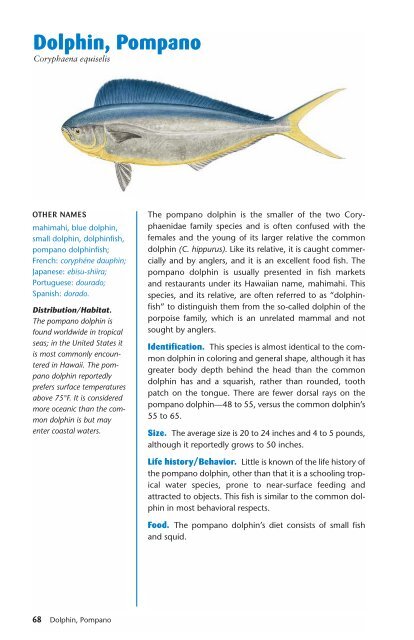Ken Schultz's Field Guide to Saltwater Fish - Macaw Pets store
Ken Schultz's Field Guide to Saltwater Fish - Macaw Pets store
Ken Schultz's Field Guide to Saltwater Fish - Macaw Pets store
You also want an ePaper? Increase the reach of your titles
YUMPU automatically turns print PDFs into web optimized ePapers that Google loves.
Dolphin, Pompano<br />
Coryphaena equiselis<br />
OTHER NAMES<br />
mahimahi, blue dolphin,<br />
small dolphin, dolphinfish,<br />
pompano dolphinfish;<br />
French: coryphéne dauphin;<br />
Japanese: ebisu-shiira;<br />
Portuguese: dourado;<br />
Spanish: dorado.<br />
Distribution/Habitat.<br />
The pompano dolphin is<br />
found worldwide in tropical<br />
seas; in the United States it<br />
is most commonly encountered<br />
in Hawaii. The pompano<br />
dolphin reportedly<br />
prefers surface temperatures<br />
above 75°F. It is considered<br />
more oceanic than the common<br />
dolphin is but may<br />
enter coastal waters.<br />
68 Dolphin, Pompano<br />
The pompano dolphin is the smaller of the two Coryphaenidae<br />
family species and is often confused with the<br />
females and the young of its larger relative the common<br />
dolphin (C. hippurus). Like its relative, it is caught commercially<br />
and by anglers, and it is an excellent food fish. The<br />
pompano dolphin is usually presented in fish markets<br />
and restaurants under its Hawaiian name, mahimahi. This<br />
species, and its relative, are often referred <strong>to</strong> as “dolphinfish”<br />
<strong>to</strong> distinguish them from the so-called dolphin of the<br />
porpoise family, which is an unrelated mammal and not<br />
sought by anglers.<br />
Identification. This species is almost identical <strong>to</strong> the common<br />
dolphin in coloring and general shape, although it has<br />
greater body depth behind the head than the common<br />
dolphin has and a squarish, rather than rounded, <strong>to</strong>oth<br />
patch on the <strong>to</strong>ngue. There are fewer dorsal rays on the<br />
pompano dolphin—48 <strong>to</strong> 55, versus the common dolphin’s<br />
55 <strong>to</strong> 65.<br />
Size. The average size is 20 <strong>to</strong> 24 inches and 4 <strong>to</strong> 5 pounds,<br />
although it reportedly grows <strong>to</strong> 50 inches.<br />
Life his<strong>to</strong>ry/Behavior. Little is known of the life his<strong>to</strong>ry of<br />
the pompano dolphin, other than that it is a schooling tropical<br />
water species, prone <strong>to</strong> near-surface feeding and<br />
attracted <strong>to</strong> objects. This fish is similar <strong>to</strong> the common dolphin<br />
in most behavioral respects.<br />
Food. The pompano dolphin’s diet consists of small fish<br />
and squid.


